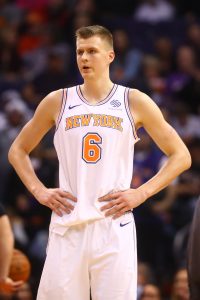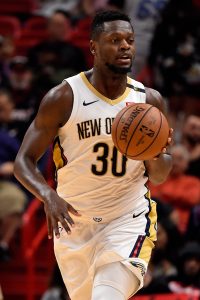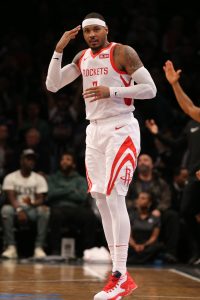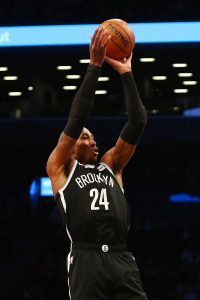When we published the first installment of our 2019 NBA free agent power rankings back in September, there were a few more big names on track for the open market next summer. However, Karl-Anthony Towns – who placed No. 2 on that list – signed a rookie scale extension with the Timberwolves and Myles Turner did the same with the Pacers.
With those top restricted free agents off the board, there are still a handful of 2019 RFAs-to-be who show up in our top 20, but the very top of our list consists almost exclusively of players who will be unrestricted free agents.
That should make 2019’s free agent period particularly interesting. After all, even if Towns hadn’t signed an early extension with Minnesota and was still on our list, there would be little drama surrounding his free agency — the Wolves had the ability to match any offer and would have done so, if necessary.
That’s not the case for unrestricted free agents though. This year’s top FAs, including Kevin Durant, Jimmy Butler, and Kawhi Leonard, could secure slightly longer and more lucrative contracts if they stay with their current teams, but otherwise there’s nothing stopping them from jumping ship. And there are no guarantees they won’t do so, which could make 2019 one of the most exciting NBA offseasons in recent years.
With all that in mind, our updated list of the top potential free agents for 2019 is below. Extensions, injuries, breakout years, trades, and poor performances figure to affect these rankings over the course of the 2018/19 campaign, so we’ll be revisiting the list again before the end of the season to make updates and changes.
Our list reflects each player’s current expected value on the 2019 free agent market, rather than how we think they’ll perform on the court for the 2018/19 season. For instance, older players like J.J. Redick and Brook Lopez have solid short-term value, but didn’t crack our top 20 because they’re unlikely to sign huge, long-term deals next summer. In other words, age and long-term value is important.
Here’s the second installment of our 2019 NBA free agent power rankings:
 Kevin Durant, F, Warriors (player option)
Kevin Durant, F, Warriors (player option)- Kawhi Leonard, F, Raptors (player option)
While Durant is probably 2019’s clear-cut top free agent, he and Leonard belong in a tier of their own as the only players who are mortal locks to get long-term, maximum-salary contracts if they stay healthy the rest of the way. They’re two-way monsters who are among the NBA’s top five players when they’re at their best. Durant is three years older than Leonard, but that won’t prevent him from securing a huge payday next summer.
- Jimmy Butler, G/F, Sixers (player option)
- Kyrie Irving, G, Celtics (player option)
If Durant and Leonard are Tier 1 free agents, Butler and Irving are in Tier 1A. They’ll surely get maximum-salary offers, but there’s uncertainty about whether they’ll get five full years at the max.
While Butler is an elite two-way player, interested teams may have concerns about his stints in Chicago and Minnesota ended. As for Irving, he has battled multiple injuries in recent years and isn’t nearly as strong a defender as the three players ahead of him on this list, though the 26-year-old’s offensive play-making and shot-making make him one of the league’s best players.
- Khris Middleton, G/F, Bucks (player option)
- Klay Thompson, G, Warriors
It’s possible I’m weighing this year’s performance too heavily here, but the truth is there may not be much difference between Middleton and Thompson in terms of their market value. Both players are excellent three-and-D wings who can knock down outside shots in bunches and handle tough assignments on the defensive end.
Middleton is a year and a half younger than Thompson and is more of a play-maker than Klay (4.0 APG vs. Thompson’s 1.8). He’s also knocking down 41.9% of his three-point attempts this year, while Thompson is making a career-worst 35.0%. Thompson may very well surpass Middleton on this list by season’s end, but for now I want to reward the Bucks swingman for his terrific start.
- Tobias Harris, F, Clippers
- Kemba Walker, G, Hornets
It seems unfair to rank Walker this low, given how good he has been for Charlotte this season. But his shooting numbers (.440 FG% and .358 3PT%) aren’t elite and he’ll be 29 when he reaches free agency. His position and size also make him less versatile than Harris, the 26-year-old forward who has posted a red-hot .508/.416/.852 shooting line this season as the scoring leader for one of the NBA’s best teams. Both of these guys will get paid big money, and would be among the top five free agents available in many other years.
- Kristaps Porzingis, F/C, Knicks (RFA)

- Nikola Vucevic, C, Magic
It’s hard to judge the relative value of these two players. One is a 23-year-old unicorn who was a lock for a five-year max before suffering an ACL tear. The other is a veteran who has taken a massive leap so far this season and is putting up career-best numbers virtually across the board. I’m giving Porzingis the edge because I think teams would still be more willing to heavily invest in him long-term, given his age and potential.
It will be interesting to see how motivated the Knicks are to get Porzingis back on the court this season — if he returns and looks great, he might inadvertently sabotage the Knicks’ tanking efforts while increasing his appeal to rival suitors.
- Nikola Mirotic, F, Pelicans
- DeMarcus Cousins, C, Warriors
Between these two bigs, I’m giving Mirotic the edge over Cousins, since an Achilles injury is one of the most difficult ailments for an NBA player – particularly a center – to come back from. It’s certainly possible that Cousins could move into the top 10 by season’s end. For now though, he’s still rehabbing that Achilles injury in an effort to get back on the court, while Mirotic is posting career-best numbers (18.9 PPG, 10.0 RPG, .465 FG%) as the stretch four in New Orleans.
- Harrison Barnes, F, Mavericks (player option)
- Marc Gasol, C, Grizzlies (player option)
- Al Horford, C, Celtics (player option)
I’ve grouped these three players together because they all fall into a similar boat, as their massive player options for 2019/20 may dissuade them from actually opting out and becoming free agents. While they could do very well for themselves on the open market, they might not be able to exceed the amount of those option salaries on new deals. Barnes’ and Gasol’s options are both worth $25MM+, while Horford’s is worth $30MM+.
As for their rankings, Barnes gets the edge due to his age and his versatility. Gasol is having the best season of the three, but will turn 34 in January, limiting his ability to get a long-term contract. Horford is in a similar position, as he’ll be 33 by next July.
- Eric Bledsoe, G, Bucks
- D’Angelo Russell, G, Nets (RFA)
- Terry Rozier, G, Celtics (RFA)
Of these three point guards, Bledsoe is having the best season so far, running the point for one of the NBA’s top teams and scoring more efficiently than ever (.519 FG%). He’s also a strong defender and will still be on the right side of 30 when he reaches the open market.
Rozier and Russell are trickier players to assess. Rozier has taken a step backward in 2018/19 after proving his worth down the stretch last season. Russell is having his best season, but still hasn’t made huge strides toward stardom, and continues to face questions about his defense. Given the nature of restricted free agency, I think they’ll both do very well on their next contracts.
- Julius Randle, F/C, Pelicans (player option)

- DeAndre Jordan, C, Mavericks
Randle gets the nod over Jordan here due to his youth and the fact that he still has room to improve. Still, despite his abilities as an inside scorer and rebounder, Randle won’t become a truly elite free agent unless he develops more as an outside shooter or rim protector.
While Jordan’s rim protection was once his calling card, he’s blocking just 1.1 shots per 36 minutes over the last two seasons after averaging 2.3 up until that point. As he enters his 30s, he’s no longer the defensive anchor or Defensive Player of the Year candidate he used to be, though he’s still a solid interior defender. His improvements at the free-throw line also increase his value — he’s making foul shots at a 75.8% rate this year after flirting with 50% for most of the rest of his career.
Also receiving strong consideration (in alphabetical order):
- Trevor Ariza, F, Suns
- Malcolm Brogdon, G, Bucks (RFA)
- Willie Cauley-Stein, C, Kings (RFA)
- Spencer Dinwiddie, G, Nets
- Goran Dragic, G, Heat (player option)
- Danny Green, G, Raptors
- Enes Kanter, C, Knicks
- Brook Lopez, C, Bucks
- J.J. Redick, G, Sixers
- Derrick Rose, G, Timberwolves
- Ricky Rubio, G, Jazz
Disagree strongly with any of our rankings? Feel like we omitted any players that should be in the top 20? Weigh in below in the comment section to let us know!
And for more names, be sure to check out our full 2019 free agents lists, sorted by position/type or by team.
Photo courtesy of USA Today Sports Images.

 Tobias Harris
Tobias Harris



